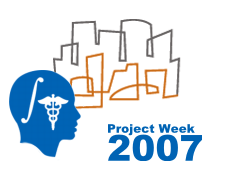Difference between revisions of "Special topic breakout: Atlases"
From NAMIC Wiki
Agouaillard (talk | contribs) |
|||
| (9 intermediate revisions by 3 users not shown) | |||
| Line 10: | Line 10: | ||
| − | <br> <br> <br> | + | <br> <br> <br> <br> |
| − | Attendees: | + | === Attendees: === |
*Gary Christensen | *Gary Christensen | ||
*Wendy Plesniak | *Wendy Plesniak | ||
| Line 18: | Line 18: | ||
*Florin Talos | *Florin Talos | ||
*Michael Halle | *Michael Halle | ||
| + | *Alex. Gouaillard | ||
| − | Agenda: | + | === Agenda: === |
| − | + | Discuss among the group what topics below of are interest to discuss, and prioritize. | |
| − | *Providing unique identifiers per structure within any atlas | + | * Define Slicer software infrastructure and conventions for atlases |
| − | *Providing a mapping from structure to unique color | + | ** Accommodating volumetric and surface based atlases |
| − | ( | + | ** Providing unique identifiers per structure within any atlas |
| + | ** Providing mapping from fiducials/landmarks to unique identifiers | ||
| + | ** Providing a mapping from structure to unique identifier to appearance attributes such as color | ||
| + | ** Providing ability to visually represent related groups of structures (''e.g.'' structures that comprise a single structural or functional system, superstructure, or designated region) | ||
| + | ** Incorporating existing systems of nomenclature and ontologies: (NeuroNames, FMA, BirnLex...) | ||
| + | ** Schemes for mapping local identifiers to names/IDs in official ontologies, (and common synonyms?) | ||
| + | ** Developing and representing both structural and functional relationships | ||
| + | ** How to perform cross-atlas indexing, combine atlas information? | ||
| + | ** Can/Should there eventually be a 'how-to create a slicer atlas' document? | ||
| + | * Slicer-based tools that work the same for all atlases | ||
| + | ** mapping atlases to individuals (for overlaying experimental data or individual image data) | ||
| + | ** interactive tools for displaying labels in various nomenclatures on mouseover | ||
| + | ** interactive tools to do both point-based and region-based indexing (useful for brain?) | ||
| + | ** interactive tools to display and navigate hierarchical relationships between structures, superstructures and substructures | ||
| + | ** compatibility with web-based tools for making queries in anatomical context | ||
| + | ** other useful interactive tools? | ||
| + | ... | ||
Latest revision as of 21:21, 21 June 2007
Home < Special topic breakout: Atlases
Return to Project Week Main Page
Atlases Breakout Session
June 26th, 3-4pm
Location: Grier Rooms A & B: 34-401A & 34-401B
Attendees:
- Gary Christensen
- Wendy Plesniak
- Brad Davis
- Florin Talos
- Michael Halle
- Alex. Gouaillard
Agenda:
Discuss among the group what topics below of are interest to discuss, and prioritize.
- Define Slicer software infrastructure and conventions for atlases
- Accommodating volumetric and surface based atlases
- Providing unique identifiers per structure within any atlas
- Providing mapping from fiducials/landmarks to unique identifiers
- Providing a mapping from structure to unique identifier to appearance attributes such as color
- Providing ability to visually represent related groups of structures (e.g. structures that comprise a single structural or functional system, superstructure, or designated region)
- Incorporating existing systems of nomenclature and ontologies: (NeuroNames, FMA, BirnLex...)
- Schemes for mapping local identifiers to names/IDs in official ontologies, (and common synonyms?)
- Developing and representing both structural and functional relationships
- How to perform cross-atlas indexing, combine atlas information?
- Can/Should there eventually be a 'how-to create a slicer atlas' document?
- Slicer-based tools that work the same for all atlases
- mapping atlases to individuals (for overlaying experimental data or individual image data)
- interactive tools for displaying labels in various nomenclatures on mouseover
- interactive tools to do both point-based and region-based indexing (useful for brain?)
- interactive tools to display and navigate hierarchical relationships between structures, superstructures and substructures
- compatibility with web-based tools for making queries in anatomical context
- other useful interactive tools?
...